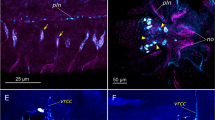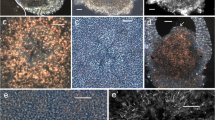Summary
Antisera to the sequence Arg-Phe-amide (RF-amide) have a high affinity to the nervous system of fixed hydroid polyps. Whole-mount incubations of several Hydra species with RFamide antisera visualize the three-dimensional structure of an ectodermal nervous system in the hypostome, tentacles, gastric region and peduncle. In the hypostome of Hydra attenuata a ganglion-like structure occurs, consisting of numerous sensory cells located in a region around the mouth opening and a dense plexus of processes which project mostly radially towards the bases of the tentacles. In Hydra oligactis an ectodermal nerve ring was observed lying at the border of hypostome and tentacle bases. This nerve ring consists of a few large ganglion cells with thick processes forming a circle around the hypostome. This is the first direct demonstration of a nerve ring in a hydroid polyp.
Incubation of Hydractinia echinata gastrozooids with RFamide antisera visualizes an extremly dense plexus of neuronal processes in body and head regions. A ring of sensory cells around the mouth opening is the first group of neurons to show RFamide immunoreactivity during the development of a primary polyp. In gonozooids the oocytes and spermatophores are covered with strongly immunoreactive neurons.
All examples of whole-mount incubations with RF-amide antisera clearly show that hydroid polyps have by no means a “diffuse nerve net”, as is often believed, and that neuronal centralization and plexus formation are common in these animals. The examples also show that treatment of intact fixed animals with RFamide antisera is a useful technique to study the anatomy or development of a principal portion of the hydroid nervous system.
Similar content being viewed by others
References
Anderson PAV, Mackie GO (1977) Electrically coupled, photosensitive neurons control swimming in a jellyfish. Science 197:186–188
Anderson PAV, Schwab WE (1982) Recent advances and model systems in coelenterate neurobiology. Prog Neurobiol 19:213–236
Ballard WW (1942) The mechanism for synchronous spawning in Hydractinia and Pennaria. Biol Bull 82:329–339
Burnett AL, Diehl NA (1964) The nervous system of Hydra. I. Types, distribution and origin of nerve elements. J Exp Zool 157:217–226
Davis LE, Burnett AL, Haynes JF (1968) Histological and ultrastructural study of the muscular and nervous system in Hydra. II. Nervous system. J Exp Zool 167:295–332
Grimmelikhuijzen CJP (1983a) FMRFamide immunoreactivity is generally occurring in the nervous system of coelenterates. Histochemistry 78:361–381
Grimmelikhuijzen CJP (1983b) Coexistence of neuropeptides in hydra. Neuroscience 9:837–845
Grimmelikhuijzen CJP (1984) Peptides in the nervous system of coelenterates. In: Falkmer S, Håkanson R, Sundler F (eds) Evolution and tumor pathology of the neuroendocrine system. Elsevier, Amsterdam, pp 39–58
Grimmelikhuijzen CJP (1985) FMRFamide-like peptides in the primitive nervous systems of coelenterates and complex nervous systems of higher animals. In: Stephano G, Greenberg MJ, Scharrer B (eds) Handbook of opioid and related peptides. CRS Press, New York (in press)
Grimmelikhuijzen CJP, Spencer AN (1984) FMRFamide immunoreactivity in the nervous system of the medusa Polyorchis penicillatus. J Comp Neurol 230:361–371
Grimmelikhuijzen CJP, Dockray GJ, Schot LPC (1982a) FMRF-amide-like immunoreactivity in the nervous system of hydra. Histochemistry 73:499–508
Grimmelikhuijzen CJP, Dierickx K, Boer GJ (1982b) Oxytocin/vasopressin-like immunoreactivity is present in the nervous system of hydra. Neuroscience 7:3191–3199
Hadži J (1909) Über das Nervensystem von Hydra. Arb Zool Inst Wien 17:225–268
Hertwig I, Hündgen M (1984) The development of gonophores and germ cells in Hydractinia echinata Fleming 1828 (Hydrozoa, Athecata). Zool Jb Anat 112:113–136
Kinnamon JC, Westfall JA (1981) A three-dimensional serial reconstruction of neuronal distributions in the hypostome of a hydra. J Morphol 168:321–329
McConnell CH (1932) The development of the ectodermal nerve net in the buds of hydra. Q J Microsc Sci 75:495–509
Müller WA (1961) Untersuchungen zur Ablaichrhythmik des Hydroidpolypen Hydractinia echinata. Zool Jb Physiol 69:325–332
Müller WA (1984) Retinoids and pattern formation in a hydroid. J Embryol Exp Morphol 81:253–271
Passano LM, McCullough CB (1964) Co-ordinating systems and behaviour in Hydra. I. Pacemaker system of the periodic contractions. J Exp Biol 41:643–664
Passano LM, McCullough CB (1965) Co-ordinating systems and behaviour in Hydra. II. The rhythmic potential system. J Exp Biol 42:205–231
Schneider KC (1890) Histologie von Hydra fusca mit besonderer Berücksichtigung des Nervensystems der Hydropolypen. Arch mikr Anat 35:321–379
Spangenberg DE, Ham RG (1960) The epidermal nerve net of hydra. J Exp Zool 143:195–201
Spencer AN (1978) Neurobiology of Polyorchis. I. Function of effector systems. J Neurobiol 9:143–157
Spencer AN (1981) The parameters and properties of a group of electrically coupled neurons in the central nervous system of a hydrozoan jellyfish. J Exp Biol 93:33–50
Spencer AN (1982) The physiology of a coelenterate neuromuscular synapse. J Comp Physiol 148:353–363
Spencer AN, Arkett SA (1984) Radial symmetry and the organization of central neurons in a hydrozoan jellyfish. J Exp Biol 110:69–90
Spencer AN, Schwab WE (1982) Hydrozoa. In: Shelton GAB (ed) Electrical conduction and behaviour in simple invertebrates. Oxford Science Publications, Oxford, pp 73–148
Stokes DR (1974) Morphological substrates of conduction in the colonial hydroid Hydractinia echinata I. An ectodermal nerve net. J Exp Zool 190:19–46
Tardent P, Weber C (1976) A qualitative and quantitative inventory of nervous cells in Hydra attenuata Pall. In: Mackie GO (ed) Coelenterate ecology and behaviour, Plenum Press, New York, pp 501–512
Triepel J, Grimmelikhuijzen CJP (1984a) A critical examination of the occurrence of FMRFamide immunoreactivity in the brain of guinea pig and rat. Histochemistry 80:63–71
Triepel J, Grimmelikhuijzen CJP (1984b) Mapping of neurons in the central nervous system of the guinea pig by use of antisera specific to the molluscan neuropeptide FMRFamide. Cell Tissue Res 237:575–586
Werner B, Chapman DM, Cutress CE (1976) Muscular and nervous systems of the Cubopolyp (Cnidaria). Experientia 32:1047–1049
Yoshida M (1959) Spawning in coelenterates. Experientia 15:11–12
Author information
Authors and Affiliations
Rights and permissions
About this article
Cite this article
Grimmelikhuijzen, C.J.P. Antisera to the sequence Arg-Phe-amide visualize neuronal centralization in hydroid polyps. Cell Tissue Res. 241, 171–182 (1985). https://doi.org/10.1007/BF00214639
Accepted:
Issue Date:
DOI: https://doi.org/10.1007/BF00214639




